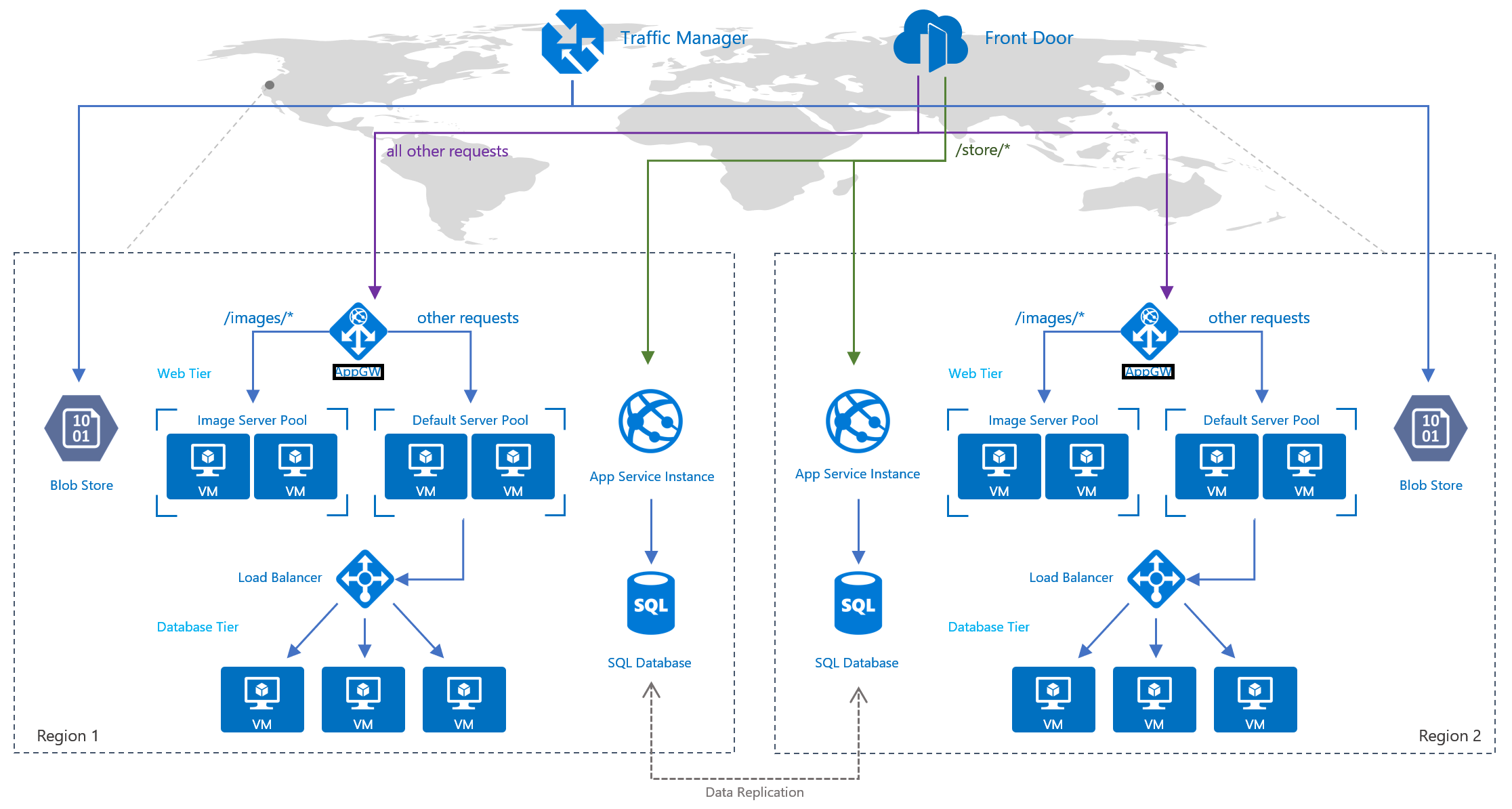
Updated 10 December 2025 by Mike Isaacs
If your website is hosted in the UK but your customers are in Europe, the US or Asia, they are all fighting the same problem – distance.
Every page has to travel across the public internet to reach your servers, pick up the content, then travel all the way back. Add peaks in traffic, security threats and regulatory pressure, and it becomes hard to keep performance where it should be.
Azure Front Door exists to solve that problem.
It is Microsoft’s global entry point for web applications and APIs, combining a content delivery network, global HTTP load balancing and integrated security in one service, built on the same network used by products such as Office 365, Bing, LinkedIn and Xbox. (Source: Microsoft Azure Blog) (Source: Microsoft Azure Blog)
This guide explains what Azure Front Door is, how it reduces latency for international users, where it fits alongside Traffic Manager and how Growcreate designs Front Door architectures for UK businesses that need speed, resilience and compliance.
Why international users experience slow websites
Two users visit the same site at the same time:
- One is in London
- One is in Singapore
If your application is hosted only in a UK datacentre, the London user connects over a short network path. The Singapore user crosses multiple networks and internet exchange points before they even reach your origin.
The result is familiar:
- Slow first page load
- Sluggish navigation between key pages
- Higher abandonment on sign-up, checkout or login
For marketing and product teams, these symptoms show up as poor conversion, inconsistent Core Web Vitals and complaints from overseas offices.
To fix this at scale you need a global application delivery layer, not just more CPU on your origin.
What Azure Front Door is and how it works
Azure Front Door is an application delivery network that sits in front of your web apps, APIs and static content.
It uses Microsoft’s global edge network to route each user to the closest point of presence, then forwards traffic to your origins over Microsoft’s private wide area network. This provides global HTTP/HTTPS load balancing, content caching, SSL offload and web application firewall on a single service. (Source: Microsoft Learn)
At a high level, the path looks like this:
- User’s browser looks up your domain (for example
www.example.com). - DNS points the request to Azure Front Door.
- Front Door routes the request to the nearest edge site using anycast, so users connect to an endpoint close to them.
- From that edge site, Front Door maintains optimised connections to your origin in one or more Azure regions.
- Responses can be cached at the edge to avoid repeated round trips.
Because most of the distance is travelled over Microsoft’s private network, latency is significantly lower compared to a direct path over the public internet. (Source: [Microsoft )
Key capabilities in plain language
Azure Front Door Standard and Premium tiers provide:
- Global HTTP/HTTPS load balancing – direct users to the fastest healthy origin based on real network latency, not just geography, with automatic failover if a region or app instance becomes unhealthy (Source: Microsoft Learn)
- Content caching and dynamic site acceleration – cache static assets and optimise dynamic traffic at the edge so repeated and heavy pages load faster (Source: Microsoft Learn)
- SSL/TLS offload and certificate management – terminate HTTPS at the edge and manage certificates centrally instead of per origin (Source: Microsoft Azure)
- Built in WAF and DDoS protection – protect against common web attacks and absorb large HTTP(S) floods before they reach your infrastructure (Source: Microsoft Learn)
- Session affinity (cookie stickiness) – keep a user on the same backend where needed for stateful sessions using managed cookies (Source: Microsoft Learn)
- IPv6 and HTTP/2 support – offer modern protocol support without changing your origin configuration (Source: Microsoft Community Hub) (Source: Microsoft Learn)
For digital teams this means one global entry point to improve speed, resilience and security without rewriting your application.
When Azure Front Door makes sense for SMEs
Azure Front Door is most valuable when:
- You serve users in multiple regions – for example a UK headquartered firm with customers across Europe, North America and the Middle East
- Revenue or engagement depends on performance – ecommerce, client portals, booking engines and membership platforms where slow pages cost money
- You are already on Azure or planning to migrate – so Front Door integrates naturally with App Service, Azure Kubernetes Service, Azure Storage and Application Gateway (Source: [Microsoft ))
- You have or need multi region deployment – active-active or active-passive architecture for high availability across Azure UK and European regions (Source: Microsoft Learn)
- Security and compliance are board topics – you need WAF, DDoS protection and clear data protection controls as standard
For smaller sites with purely local audiences, simpler Azure load balancing and caching patterns may be sufficient. For growing SMEs with international traffic and regulatory pressures, Front Door becomes a strong way to keep the platform fast and dependable.
How Azure Front Door reduces latency for international users
If you are wondering how to reduce website latency for international users without rebuilding your stack, Azure Front Door addresses three main bottlenecks.
1. Shorter network paths
Front Door uses anycast to route each user to the nearest edge site, then forwards requests to your origin over Microsoft’s private backbone rather than random public internet hops. Microsoft reports that this can improve latency by up to three times for global applications. (Source: [Microsoft ))
From the user’s point of , your site feels “local” even if it is hosted in an Azure UK datacentre.
2. Caching at the edge
Static assets and cacheable responses can be stored at edge locations around the world. When a user in Singapore requests a page that has already been cached, the content is served directly from the nearest edge site instead of your origin, which cuts round trips and reduces load on your servers. (Source: Microsoft Learn)
Even short cache lifetimes on dynamic responses can make a noticeable difference during peaks.
3. Modern protocols and connection reuse
HTTP/2 support, connection multiplexing and optimised TCP handling mean fewer separate connections and less overhead per request. Front Door keeps warm connections to your origin so back-end calls reuse existing routes instead of opening new ones for every request. (Source: Microsoft Learn)
How Growcreate measures impact
Before recommending Front Door, Growcreate benchmarks your current latency and throughput using global synthetic tests and real user data. We combine Azure-native monitoring with our IntelligentMonitor platform to spot bottlenecks across multiple regions and domains. (Source: Growcreate)
After go-live we track the same metrics again so you have a clear of ROI in milliseconds saved, error rate reduction and conversion uplift where data is available.
Built In SSL, WAF And DDoS Protection
Many teams ask how to add SSL, WAF and DDoS protection to a web app without stitching together multiple products.
Azure Front Door Premium brings these controls into one place:
- TLS/SSL termination at the edge – HTTPS is terminated at Front Door, with built in certificate lifecycle management and the option to bring your own certificates via Azure Key Vault (Source: Microsoft Azure)
- Web application firewall – central rules to block common attack patterns based on OWASP Top 10, plus custom rules for your specific application behaviour (Source: Microsoft Azure Blog)
- Layer 3, 4 and 7 DDoS protection – volumetric, protocol and application level attacks are absorbed and filtered across the global edge, keeping malicious traffic away from your origin (Source: Microsoft Learn)
For UK businesses handling personal or financial data, this simplifies your security story. You gain a consistent security layer in front of all your public endpoints, rather than a patchwork of per-site controls.
Growcreate designs Front Door rules in line with your risk profile and sector regulations, then integrates logging with your existing monitoring so your internal teams keep visibility.
High availability and global HTTP load balancing
Front Door is a global HTTP load balancer as well as a CDN. It monitors the health of each origin and directs users to the best option in real time. (Source: Microsoft Learn)
Health probes and automatic failover
Front Door continuously checks each origin using configurable health probes. If a region or instance fails, it can fail over to a secondary origin according to priority rules. (Source: Microsoft Learn)
This gives you:
- Protection against regional outages
- Safer planned maintenance windows
- Smoother blue/green or canary deployments across regions
In multi region Azure architectures, this is a straightforward way to achieve global failover without changing application code.
Session affinity where you need it
For stateful workloads, cookie-based session affinity ensures each user stays on the same origin for the life of their session. Front Door injects its own session cookies and routes subsequent requests accordingly. (Source: Microsoft Learn)
Growcreate uses this selectively, so you maintain stickiness where business logic requires it without creating unnecessary coupling between users and regions.
Azure Front Door vs Traffic Manager for global apps in UK datacentres
A frequent question is whether to choose Azure Front Door or Traffic Manager for global apps hosted in Azure UK datacentres.
Both services distribute traffic across regions and provide failover. The key differences are where they operate and which features you get.
Conceptual differences
- Traffic Manager is a DNS based load balancer. It answers DNS queries with the best endpoint based on rules such as priority or latency, then the client connects directly to that endpoint. (Source: [Microsoft ))
- Azure Front Door is an application delivery network. It terminates HTTP/HTTPS at the edge, applies caching and WAF rules, then forwards traffic to your origins over Microsoft’s network. (Source: [Microsoft ))
Microsoft’s own guidance is that for workloads hosting HTTP applications, Front Door is the natural choice because it adds CDN, TLS termination and integrated firewall on top of load balancing. (Source: Microsoft Learn)
Practical recommendation for UK based global apps
For most UK based web applications and APIs that:
- Serve users in multiple countries
- Run primarily over HTTP/HTTPS
- Require WAF and DDoS protection
Growcreate typically recommends Azure Front Door as the primary global entry point, with origins hosted in Azure UK regions such as UK South and UK West, plus additional European regions if needed.
Traffic Manager remains useful for:
- Non HTTP workloads
- Hybrid or multi cloud patterns
- DNS based failover between separate front doors or application gateways
In many architectures the two services complement each other, but for SME websites and portals Front Door alone is often enough.
Data protection, Azure UK regions and GDPR
Data protection is a core concern for UK organisations, especially where personal data crosses borders.
Azure offers regional hosting in UK South and UK West, with wide support for ISO 27001 and GDPR aligned controls. Microsoft has also demonstrated adherence to the EU Cloud Code of Conduct, which is specifically designed to support GDPR Article 28 obligations for cloud processors. (Source: Microsoft Learn) (Source: Azure)
Azure Front Door is a non regional service. To accelerate and protect traffic it caches and processes customer data at edge locations around the world. Microsoft is explicit that because of this, not all Front Door traffic can stay within EU or UK boundaries. (Source: Microsoft Learn)
In practice that means:
- Your primary data storage and processing can remain in UK regions
- Front Door will still transfer and cache some data globally in order to accelerate delivery
- You should document these flows as part of your data protection impact assessment and supplier contracts
Growcreate helps you design Front Door and origin architectures that respect sector regulation and UK GDPR, then provides the documentation your compliance and legal teams need. (Source: Growcreate)
Pricing, data transfer and ROI
Azure Front Door uses consumption based pricing. You pay for:
- Data transferred out from Front Door edges to users
- HTTP/HTTPS requests through the service
- Optional add ons such as premium security capabilities
Standard and Premium tiers bundle different levels of security and private link features, but both follow the same pay-per-use model. (Source: Microsoft Azure)
The important point for SMEs is that costs are driven by real usage rather than fixed capacity. Caching can significantly reduce origin egress and compute, and there are no extra charges for data transferred from Azure regions into Front Door. (Source: Microsoft Azure)
Growcreate models Front Door costs against your existing hosting bills to produce a simple comparison:
- Baseline: current hosting, bandwidth and downtime cost
- With Front Door: projected monthly Front Door charges, reduced origin egress and potential revenue impact from improved performance and availability
This makes it easier to present a clear business case to boards and budget holders.
How Growcreate designs, implements and runs Azure Front Door
Growcreate is an Azure cloud specialist that designs, hosts and optimises digital platforms for organisations in regulated and performance sensitive sectors. (Source: Growcreate)
Our typical Azure Front Door engagement includes four phases.
1. Assessment and architecture
We begin with a short discovery to understand:
- Where your users are located today
- Which applications and domains are in scope
- Existing Azure resources such as App Service, Application Gateway and Storage
- Security, compliance and SLA requirements
From there we design an Azure reference architecture covering Front Door, origin regions, caching strategy and WAF policy. If you are running Umbraco, Optimizely or a custom .NET application, we align this with your CMS or portal roadmap. (Source: Growcreate)
2. Implementation and migration
We then:
- Build Front Door profiles, routes, origin groups and health probes
- Configure SSL certificates and domain mappings
- Implement initial WAF rules and rate limiting
- Set up observability for latency, error rates and security events
Cutover is planned to minimise risk. Where needed, we start with a subset of traffic, then scale up as confidence grows.
3. Performance and security tuning
Once live, we fine tune based on real data:
- Adjust caching rules and headers to balance freshness and speed
- Refine routing methods for multi region behaviour
- Harden WAF rules to reduce false positives while blocking real threats
We track these changes through dashboards so you can see improvements in response times and stability over time.
4. Ongoing managed service
Many clients ask Growcreate to operate Front Door as part of a wider Azure managed hosting and 24/7 support service, including:
- Monitoring and incident response
- Regular security
- Cost and performance optimisation
This fits into Growcreate’s broader Azure Cloud Services offering, where we manage cloud environments for uptime, cost and compliance. (Source: Growcreate)
Is Azure Front Door right for your platform
Azure Front Door is likely a good fit if:
- You see noticeably slower performance for users outside the UK
- Your site or portal is business critical, not brochureware
- You are already committed to Azure or planning a move
- Your security team is asking for centralised WAF and DDoS protection
- You are exploring multi region deployment for resilience
If you recognise yourself in at least three of these points, a focused assessment is usually worthwhile.
Growcreate offers a Front Door and global performance where we:
- Benchmark current latency and availability across key locations
- Map your existing Azure topology
- Compare options such as Front Door, Traffic Manager and Application Gateway
- Provide a clear recommendation and ballpark cost
You can start that conversation through our Azure Cloud Services page. (Source: Growcreate)
Azure Front Door FAQs for Ddigital teams
How does Azure Front Door reduce latency for international users
Front Door brings your site closer to users by terminating traffic at edge locations worldwide, then forwarding it over Microsoft’s private network to your UK origins. It also caches content locally and uses HTTP/2 to reduce overhead per request, which together cut page load times for overseas visitors. (Source: [Microsoft )) (Source: Microsoft Learn)
What are the benefits of a global application delivery network for SMEs
For SMEs, an application delivery network such as Azure Front Door provides:
- Faster sites for international users without building datacentres in every region
- Higher availability through automatic failover between origins
- Centralised SSL, WAF and DDoS controls
- More predictable performance during campaigns and traffic spikes
This levels the playing field with much larger competitors who already operate globally.
How do I add SSL, WAF and DDoS protection to an Azure web app
If your app runs on Azure App Service, AKS or another HTTP based service, you can place Azure Front Door in front of it. Front Door handles TLS termination, provides integrated WAF rules and includes DDoS protections at the edge, so you gain these controls without changing application code. (Source: Microsoft Azure) (Source: Microsoft Learn)
How does global HTTP/HTTPS load balancing work for multi region applications
Front Door defines origin groups that represent your regions. Using latency or priority routing methods, it sends each request to the origin with the best measured network latency, and fails over automatically if health probes detect a problem. This provides global HTTP/HTTPS load balancing across Azure regions. (Source: Microsoft Learn)
Is Azure Front Door compliant with UK data protection requirements
Azure provides a wide range of GDPR focused features and certifications, and Microsoft has aligned Azure with the EU Cloud Code of Conduct to support GDPR Article 28 obligations. (Source: Microsoft Learn)
However, Azure Front Door is a non regional service that caches and processes data globally, so some customer data will leave the UK to be served from edge locations. (Source: Microsoft Learn)
With the right architecture you can keep primary data stores in UK regions while documenting and justifying the remaining cross border flows. Growcreate works with your legal and compliance teams to ensure this is understood and managed.



